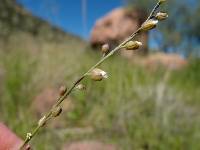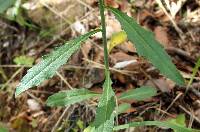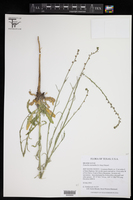|
|
 Flower stalk Sue Carnahan @http://swbiodiversity.org, Usage Rights: CC BY-NC (Attribution-Non-Commercial) |  Leaves Stephen Hale @http://swbiodiversity.org, Usage Rights: CC BY-NC (Attribution-Non-Commercial) |  Plant University of Texas at Austin Herbarium, Usage Rights: CC0 1.0 (Public-domain) | | | |
|
Origin:
Native
Life Cycle:
Biennial or perennial
General Desc:
Small biennial or perennial; erect branches can be simple or many, arising from basal rosette; often leafless; stems hairy near the base, becoming less hairy further from base; sepals purple or green enclose much of the petals; white or purplish petals.
Identification notes: Basal leaves absent at flowering, stem leaves lance-like, narrowest at stem, margin usually toothed; flowers on multiple sides of elongated stems, white or purplish, oblong; fruits slender, to 2-1/2 inches, stalks somewhat erect; seeds not winged.
Height:
1 to 2-1/2 feet
Habitat Description: Found on loamy (rich), volcanic, and igneous soils, in pine-oak forests, grasslands, and along cliffs.
Plant Communities:
Semidesert Grasslands, Pinyon Juniper Woodland, Montane Conifer Forest
Elevation: 3000 - 7000 feet
Color:
White or purplish
Shape:
Regular in elongated clusters
Tubular:
N
Flowering Period:
Jun - Sep
Description:
Flowers white or purplish, small and occasionally bunching in leaf axils; purple or green sepals enclose much of the petals; petals spatula-like to narrow, on slender stalks 1/8 to 1/2 inch long.
Leaf Color:
Green
Leaf Type:
Simple
Leaf Shape:
Narrow
Leaf Margin:
Toothed
Leaf Attachment:
Basal and alternate
Leaves Clasp:
N
Hairs:
Leaves and stems
Spines:
N
Leaf Description:
Leaves sparse (are early deciduous and easily separated from plant), with variable margins (can be strongly wavy, lobed, toothed, or smooth), hairs with tree-like branching; basal leaves narrow, 3/4 to 2 inches long, stem leaves oblong to narrow.
Fruit Type: Pod
Fruit Notes: Fruits erect to ascending, straight, up to 2-1/2 inches long; partitions transparent; ovules 90 to 140 per ovary.
Seed Notes: Seeds biseriate (arranged in 2 rows) or uniseriate (arranged in a single series), plump, not winged, oblong; seed coat slimy when wet.
|
|